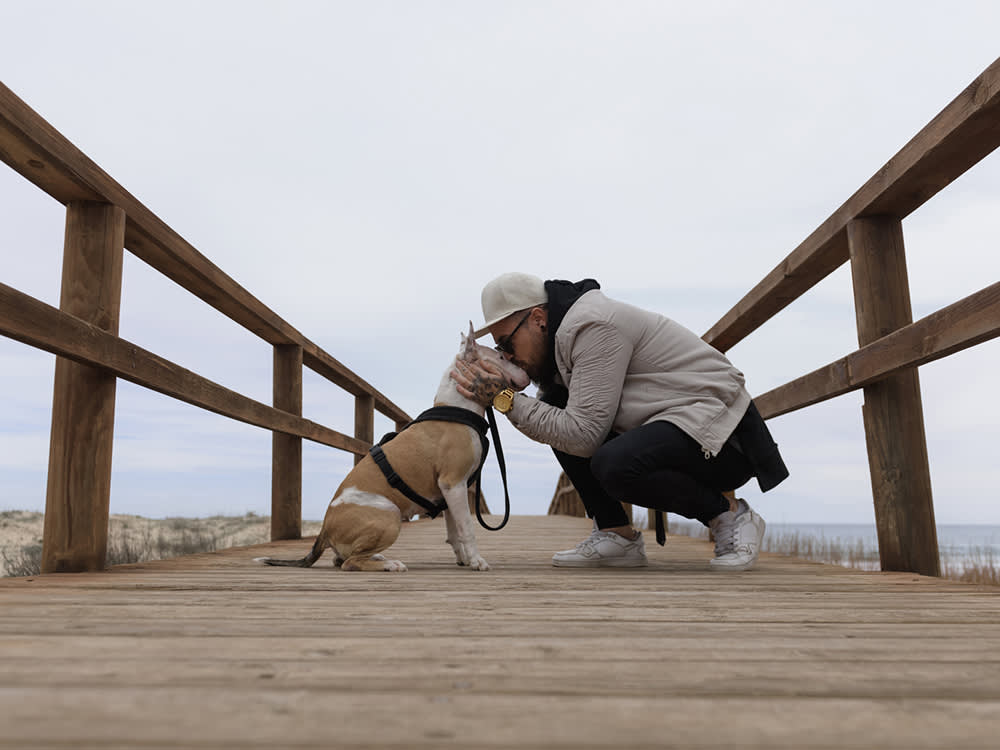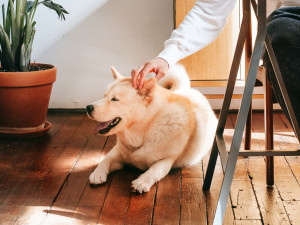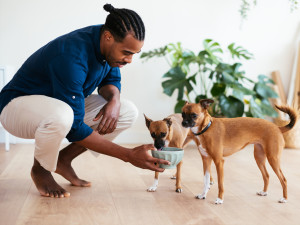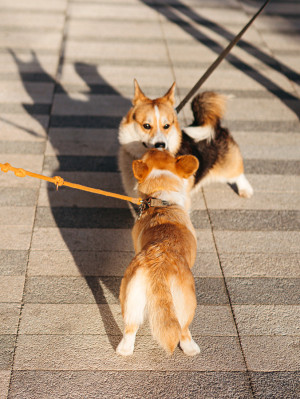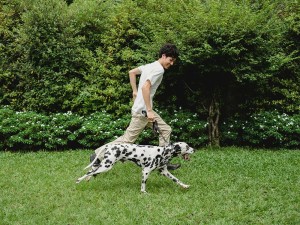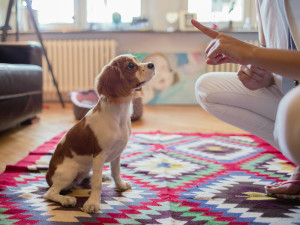Best Training Rewards for Your Dog
Positive reinforcement is in the eye of the beholder
Visualize this scenario: Comet, a six-month-old Labrador in a beginner-level dog training class, ignores all distractions and charges back to her person, Olivia, after hearing “Comet, come!” As soon as she arrives, Comet receives effusive praise and petting from Olivia. A great example of positive reinforcement, right? Except that, in this very common situation, Comet responds to the actions of her pet parent by turning her head away as though in disgust.
What is Positive Punishment?
Positive punishment in dog training is when you give an unwanted “reward” (like an overly enthusiastic pat) after a dog does what you asked, which may make the dog less likely to do that behavior again. Olivia’s actions were a perfect example of positive punishment. Olivia couldn’t have done a better job of teaching Comet to ignore her if she had tried.
Trick question: All dogs are perfect! But find out which type is the best fit for you.
But wait — don’t dogs love to be petted? Don’t they love to be praised? Well, yes, they do. But then, no, they don’t. Lest you think I’m messing with your mind, put yourself in your dog’s position for a moment. Ah, yes, I know — being anthropomorphic can cause a lot of problems, but that doesn’t mean it isn’t useful sometimes.
Bear with me here: Imagine that you’ve just done something wonderful, and your boss wants to thank you. She gives you a box of expensive chocolates, the kind infused with exotic flavors, like lavender and chili. You know she spent a fortune on them. Except, you don’t like lavender-chili chocolate; you like good old-fashioned milk chocolate from Hershey, Pa. Or, maybe you love flavored chocolate, but you’re on a diet, and being presented with a pound of chocolates is akin to torture.
How much do you spend on your pet per year?
The dog in the training class and you as an employee are in the same position: Someone is trying to give you “positive reinforcement” for a behavior they’d like you to repeat, but what they’re giving you is something they define as good and you define as, well, not very. Dogs may love petting, but not all versions of it, and not in every context. Praise may be music to their ears, but not all the time, or maybe they like funk and you’re singing jazz.
Avoiding Positive Punishment
Many people know that using positive reinforcement in dog training is the most effective way to influence behavior, but knowing how to use it effectively takes more than remembering to carry cookies in your pocket. Without a doubt, one of the most common problems people have when using positive reinforcement is not being thoughtful enough about what their dog defines as positive. Of course, small bits of tasty food are fundamental for training a dog who truly loves to do what you ask, but they are not enough.
Treats & Food
You’re not always going to have treats in your pocket, and your dog isn’t always going to be hungry (well, that’s true for some of our dogs, anyway). When you do use treats, keep in mind that the most frequent mistake beginners make is to use bland, boring stuff akin to a solitary oyster cracker. Good enough if you’re really hungry, but not worth leaving a plate of linguini with braised spinach and caramelized tomatoes for — or, if you’re a dog, a greasy food wrapper in the gutter.
But food, even great food, is never enough. The last thing you want is a dog who listens to you if you have edibles in your pocket and ignores you the rest of the time. And, although it’s hard to imagine if your own pup is a furry garbage disposal, there really are dogs who just don’t care all that much about food.
Petting & Praise
That brings us to petting and praise, which can also be great reinforcements if the dog truly likes to be petted (pats on top of the head appear to be as aversive to dogs as they are to people) and if it’s given at a time when a dog really wants it. Otherwise, an eight-month-old Lab/Husky cross is probably going to see pats on the head as positive punishment. He doesn’t want to be petted when he’s in the middle of play any more than you want to have your back rubbed during an important business meeting. Thus, food, petting and praise are great reinforcers if and only if they’re something your dog wants at the time they’re given, as opposed to something that makes you feel good for giving them.
Choosing the Right Rewards
But there’s much more to positive reinforcement than dog treats, pets and praise. When avoiding positive punishment great trainers become truly creative, and is often the reason some dogs are phenomenally responsive.
My favorite story of creative reinforcement comes from Kinship writer and CAAB Dr. Karen B. London. She was out with her newly acquired Lab mix, Bugsy, when they flushed a deer. She called the dog to come just before he sprang off in pursuit, and to her joy and amazement, he turned and ran back to her. Alas, before their outing, she had switched jackets on the fly and inadvertently left her training treats at home. She couldn’t even take off running to let Bugsy chase her because she was wearing cross-country skis and facing the wrong way in the ski track. Ever the quick thinker, Karen reached into her pocket, took out a used tissue and gave it to Bugsy when he arrived. Voila! Her dog was thrilled at this acquisition, and Karen’s creative thinking laid a foundation for a solid recall for years to come.
However, there are many more ways to expand your repertoire — you just need to know what your dog loves. More creative examples positive reinforcements:
Letting the dog have limited access to the very distraction they had been called away from (compost heap, dead bird, garbage bag).
Use “life rewards,” meaning the dog gets what they want as a matter of course during the day (say, going outside after waiting at the door).
Use a well-known cue as a reinforcer. For example, most dogs know how to sit on cue, and if you’ve used positive reinforcement to train this behavior, the cue itself becomes a secondary reinforcer: “If I sit as asked I’ll get a treat! I love to sit!”
Effective positive reinforcements include ice cubes, snowballs, bunny poop, cheering and clapping, pine cones, feathers, paper-towel tubes, digging, being allowed to sniff interesting things, running around the yard in crazy circles … and on and on. You can see that the list is almost endless — you’re constrained only by the number of things that make your dog happy and being mindful of your dog’s safety (e.g., you can sniff some things but not ingest them).
One smart agility trainer had a dog who, no matter what she tried, would not go around the last weave pole. Then she remembered that her dog loved to jump into the car, so she set up the poles leading toward the car and used jumping in as a reward for weaving around the last pole.
Unconventional Training Tactics
Another agility trainer taught a fearful dog to enjoy the teeter board by using scent marking as a reward. Turns out the dog loved to lift his leg and mark objects, so every time he took one step closer to walking across the teeter, he got to lift his leg on the fence! This is a perfect example of what psychologists call the “Premack principle,” which says that a more-probable behavior can be used to reinforce a less-probable behavior. In other words, if your dog loves to dig, there’s a high probability he’ll do it if he has the chance. If that’s true, you can use digging as a reinforcer, secure in the knowledge that he must love it if he does it so often. If there is a low probability he’ll come when called after he’s seen a squirrel, you can use digging to reinforce a recall in that context.
Another positive reinforcement tool that’s always handy to have is putting a problem behavior on cue and then using it as a reinforcer. My absolute favorite example of this came from someone whose dog loved mouthy play. The guardian put it on cue by saying “Rabies!” Now, she not only has control over the behavior, she can use it as a reinforcement. Brilliant! I did something similar (although nowhere near as funny) with Lassie by teaching her to jump up on me when I said “Be bad!” Lassie had come to me at 11 months as one of the worst leapers I’d ever seen. She’d launch herself up to a visitor’s face and, suspended midair, put her tongue halfway down his throat (we called her the French-kissing queen). It took many months, but I eventually taught her to sit while greeting company by using food treats and putting jumping-up on cue. She still loved to leap toward faces, so it turned out to be a great way to thank her for doing what I had asked, including sitting politely for company.
I’ll end on my current favorite example of creative thinking. One guardian had a scent-hound mix named Maggie who couldn’t be trusted off-leash. As happens to the best of us, the dog got out of the house one day and was just about to take off when the guardian spotted one of Maggie’s best friends close by. Nope, not another dog, but rather, a cat she loved to play with (a mutual pleasure, I’m happy to report). Our quick-thinking guardian grabbed the cat, held him up in the air and said “Maggie! Kitty!” and her dog came running. The three of them dashed into the house together, the dog and cat played joyfully, and the guardian breathed a sigh of relief. Now, that is quick thinking! Granted, we can’t all grab a nearby cat, but I’ll bet there are at least five things your dog loves that you haven’t used yet.
